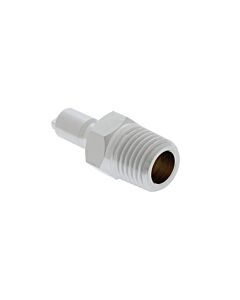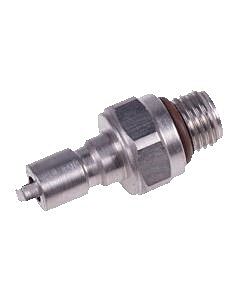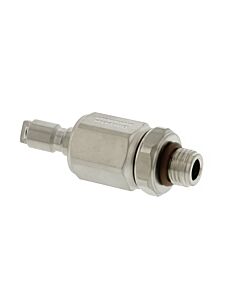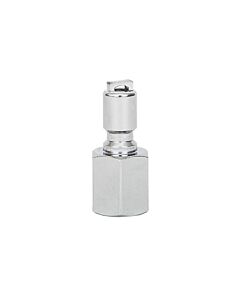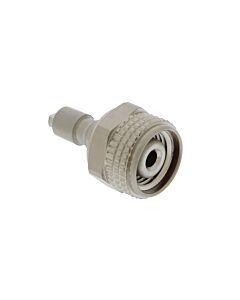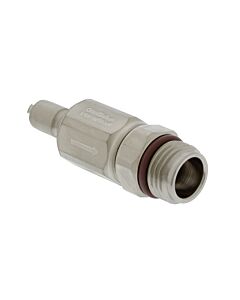Quick Disconnects (LP) - Low Flow
These quick disconnect fittings are suitable for low flow applications using the dive industry Schrader fittings found on BC and Drysuit power inflators.
-
 DGX Adapter: LP Reg Hose = BC InflatorAs low as $11.00
DGX Adapter: LP Reg Hose = BC InflatorAs low as $11.00
 WARNING
WARNING
You can not use a standard BC inflator QD hose Schrader fitting to supply a regulator 2nd stage or a BC integrated alternate air source, as the device would not receive enough gas due to the flow restriction of a standard Schrader fitting.
Quick-Disconnect Compatibility and Lack Thereof
Divers are sometimes surprised to learn there is NO universal standard that defines the precise shape and exact dimensions of the compressed gas quick-connect coupling systems used in SCUBA. This can cause compatibility issues with the connection: the fittings will not connect at all; the fittings will not securely connect and can self-disconnect without any overt user action; the fittings will securely connect but gas will not flow; the fittings will connect but will exhibit slow leaks.
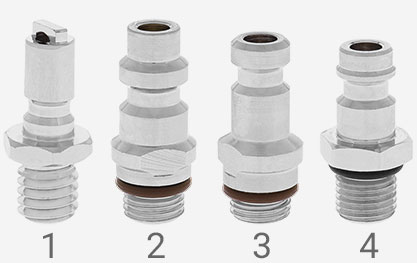 There is the further complication that the low-flow fitting commonly seen on power-inflators is not suitable for high-flow required by SCUBA regulators, so fittings found on BC integrated second-stages use something else entirely.
There is the further complication that the low-flow fitting commonly seen on power-inflators is not suitable for high-flow required by SCUBA regulators, so fittings found on BC integrated second-stages use something else entirely.
- Low-flow BC power-inflator Schrader valve post used on BCDs and SMBs
- High-flow BC integrated 2nd stage post used on the ScubaPro Air II & Atomic SS1 and many others
- High-flow BC integrated 2nd stage post used on the obsolete SeaQuest style devices
- High-flow BC integrated 2nd stage post used on the Mares Air Control & Aqualung Air Source 3 and many others
The low-flow posts used for inflation with the female Schrader valve couplings on low-pressure hoses seen in recreational diving can be further divided into two styles:
- A widely seen post with a shorter barrel and a raised bridge across the top (BC QD, aka Hansen) typically encountered on products from Asia. This post is on virtually all ordinary power inflators used with BCDs and SMBs in North America. Pictured in #1 above.
- A less commonly seen post with a slightly longer barrel and a flat top (International, aka DIN, aka SeaTec) is more likely to be encountered on products from the UK and Europe because there is an EN standard for the fitting. The International post is seen on nearly all current recreational diving drysuits because the two most dominate wholesale manufacturers of drysuit inflation valves are Apeks (UK) and SI TECH (Sweden).
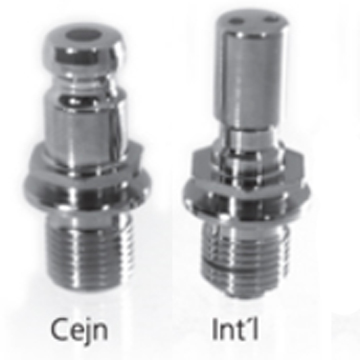 Finally there are other quick-connect couplings occasionally encountered in recreational diving.
Finally there are other quick-connect couplings occasionally encountered in recreational diving.
- The CEJN original 5mm low-pressure high-flow fitting manufactured by CEJN AB of Sweden is notable for its reliability. Today, the CEJN proprietary fitting is typically encountered on the inflation valves of drysuits used in commercial diving while most drysuits in recreational diving use the International fitting.
- The QD system of fittings from Omniswivel International use a coupling and post specifically designed for low-pressure high-flow breathing air applications. The QD post looks similar to CEJN but Omniswivel states their QD system is NOT intended to be compatible with CEJN.
- The Milton Industries M-style (aka Industrial Interchange Type 'D') fitting is widely used with low-pressure high-flow compressed air driven industrial tools and typically encountered on inflation valves of heavy-duty salvage lift bags used in commercial diving.
- The QC6 is a quick-connect system manufactured by Swagelok. QC6 is advantageous because the low-pressure high-flow fittings have shutoffs in both ends and can be operated while pressurized for dive applications that require managing the connection with minimal ingress of water. The QC6 fittings are typically seen connecting offboard low-pressure gases into closed-circuit rebreather loops.
- Also manufactured by Swagelok, the QF4 is a high-pressure compact quick-connect system offering bi-directional flow with no shutoffs. QF4 style fittings are used in the DGX Gears blending and transfill system of components. The connection must NOT be uncoupled while under pressure.
First the good news... low-flow fitting incompatibilities are rare. All the low-pressure quick-disconnect inflation hoses we sell are compatible with the BC QD post found on our replacement power inflator as well as the inflators on all the BCDs and SMBs we sell plus the SI TECH and Apeks drysuit inflation valves with International fittings. We occasionally see compatibility problems with these posts and various adapters.
Now the bad news... high-flow fitting compatibility problems are commonplace. You can not use a standard inflation hose to supply a BC integrated alternate air source, as the device would not receive enough gas due to the restriction of a low-flow fitting. There are several different types of the high-flow fitting commonly seen on BC integrated second stages. If you are concerned about compatibility, the best strategy might be to replace the hose with the same brand from the same source as the original equipment manufacturer. If you can't find an OEM hose then we do stock high-flow adapters that allow any standard-length LP regulator hose to be converted into a quick disconnect hose for modern BC integrated alternate air sources.






